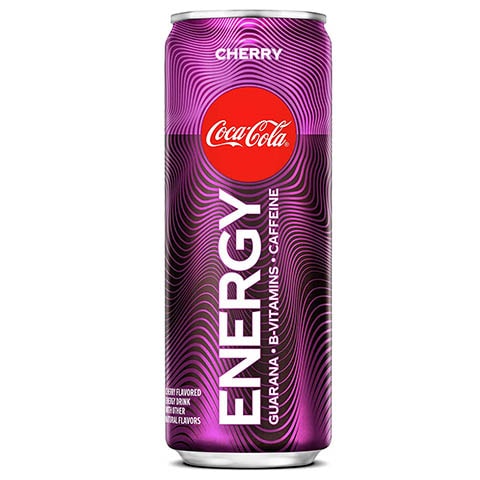
Note: As of May 2021, Coca Cola Energy is no longer distributed in North America.
Coca-Cola is one of the most popular drink companies, but you may not have heard of one of their newer drinks, Coca-Cola Energy. It’s the company’s first official Coke-branded non-soda drink. It comes in four different varieties: Coca-Cola Energy, Coca-Cola Energy Cherry, and Zero Sugar versions of both.
Although initially only available in Europe and Australia, the new Coca-Cola Energy drinks were launched in the United States in January 2020. You might be curious as to how this new Coca-Cola product stacks up to a standard can of Coke or other energy drinks on the market, especially with Coca-Cola-partnered Monster Energy. Keep reading to find out more! One can of Coca-Cola Energy contains 114 milligrams of caffeine.
How Much Caffeine is in Coca-Cola Energy?
Filled with the classic Coca-Cola taste, Coca-Cola Energy offers the classic comforts of the beloved soda mixed with an extra kick. While Coca-Cola is a refreshing soda beverage, the new Coca-Cola Energy has three times the caffeine of a normal can of Coke while still giving that classic cola soda taste. According to the nutritional information on the website, Coca-Cola Energy drinks contain 114mg of caffeine per 12 oz. can.
Considering that drinks can have varying caffeine levels, starting relatively low like the 34mg in a single can of regular Coke to the whopping 300mg in a can of Bang Energy, Coca-Cola Energy hovers around the middle of the pack with its 114mg of caffeine. In addition to the average caffeine content, a can of Coca-Cola Energy contains added B vitamins and Guarana extract for extra caffeine and antioxidants.
Depending on your energy drink of choice, the caffeine content per can will be somewhere around 100mg of caffeine. For example, Red Bull contains 111mg of caffeine, and the Original Monster flavor has around 160mg per can. While there are drinks like Bang Energy, which contains a hefty 300mg of caffeine per can, Coca-Cola Energy certainly holds its own in the saturated energy drink market.
The true selling point of Coca-Cola Energy is its ability to provide an equivalent amount of caffeine while still tasting like the fan-favorite soda. All offered flavors of Coca-Cola Energy have the same amount of caffeine per can, leaving you to be the only deciding factor on which flavor you prefer.
Caffeine Content Comparison
Let’s take a closer look at how Coca-Cola Energy stacks up to its main competitors and its caffeine content compared to standard soda, coffee, and even tea.
Coca-Cola Energy Versus Other Energy Drinks
| Revive Energy Mint | 12oz can | 114mg |
| Monster Energy | 16oz can | 160mg |
| Redbull Energy | 12oz can | 111mg |
| Rockstar Energy | 16oz can | 160mg |
| Bang Energy | 16oz can | 300mg |
Coca-Cola Energy Versus Coffee
| Revive Energy Mints | 12oz can | 114mg |
| Brewed Black Coffee | 8oz | 96mg |
| Espresso | 1oz | 64mg |
| Instant Coffee | 8oz | 62mg |
Coca-Cola Energy Versus Tea
| Revive Energy Mints | 12oz can | 114mg |
| Black Tea | 8oz | 47mg |
| Green Tea | 8oz | 28mg |
| Bottled Tea | 8oz | 19mg |
Coca-Cola Energy Versus Soda
| Revive Energy Mints | 12oz can | 114mg |
| Diet Coke | 12oz | 47mg |
| Pepsi | 12oz | 39mg |
| Coca-Cola | 12oz | 34mg |
| Mountain Dew | 12oz | 54mg |
| Dr Pepper | 12oz | 41mg |
| Barq’s Root Beer | 12oz | 22mg |
As far as caffeine content goes in each can of Coca-Cola Energy, you can see it’s not only comparable but also a strong contender in the energy market.
Enjoy in Moderation
The FDA and other scientific studies recommend you have no more than 400mg of caffeine every day. If you like to drink your cup of coffee in the morning, which is normally larger than just 8 ounces, and you enjoy an afternoon soda, you’re already over the halfway point. It is better to be safe than sorry, and over-indulging in caffeine can leave you with some nasty side effects.
Also see:
















